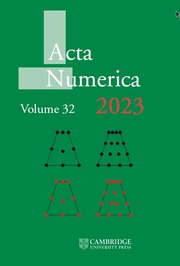No CrossRef data available.
Article contents
Cut finite element methods
Published online by Cambridge University Press: 01 July 2025
Abstract
Cut finite element methods (CutFEM) extend the standard finite element method to unfitted meshes, enabling the accurate resolution of domain boundaries and interfaces without requiring the mesh to conform to them. This approach preserves the key properties and accuracy of the standard method while addressing challenges posed by complex geometries and moving interfaces.
In recent years, CutFEM has gained significant attention for its ability to discretize partial differential equations in domains with intricate geometries. This paper provides a comprehensive review of the core concepts and key developments in CutFEM, beginning with its formulation for common model problems and the presentation of fundamental analytical results, including error estimates and condition number estimates for the resulting algebraic systems. Stabilization techniques for cut elements, which ensure numerical robustness, are also explored. Finally, extensions to methods involving Lagrange multipliers and applications to time-dependent problems are discussed.
Information
- Type
- Research Article
- Information
- Creative Commons
- This is an Open Access article, distributed under the terms of the Creative Commons Attribution licence (http://creativecommons.org/licenses/by/4.0/), which permits unrestricted re-use, distribution, and reproduction in any medium, provided the original work is properly cited.
- Copyright
- © The Author(s), 2025. Published by Cambridge University Press

